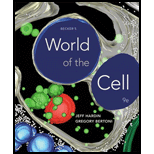
Concept explainers
QUANTITATIVE Cell Sizes. To appreciate the differences in cell size illustrated in Figure 1-3a, consider these specific examples. Escherichia coli, a typical bacterial cell, is cylindrical in shape, with a diameter of about 1 μm and a length of about 2 μm. As a typical animal cell, consider a human liver cell, which is roughly spherical and has a diameter of about 20 μm. For a typical plant cell, consider the columnar palisade cells located just beneath the upper surface of many plant leaves. These cells are cylindrical, with a diameter of about 20 μm and a length of about 35 μm.
(a) Calculate the approximate volume of each of these three cell types in cubic micrometers. (Recall that V = πr2h for a cylinder and that V = 4πpr3/3 for a sphere.) Use three significant figures for these calculations.
(b) Approximately how many bacterial cells would fit in the internal volume of a human liver cell?
(c) Approximately how many liver cells would fit inside a palisade cell?
Want to see the full answer?
Check out a sample textbook solution
Chapter 1 Solutions
Becker's World of the Cell (9th Edition)
- Part A - Comparing plant cells and animal cells Plant cells and animal cells share many of the same structures, but each type of cell also has unique structures. In this activity, you will indicate which cell structures are found only in plant cells, only in animal cells, or in both plant and animal cells. Drag each cell structure to the appropriate bin. If a structure is found in both plant cells and animal cells, drag it to the "both" bin. ► View Available Hint(s) chloroplast plant cell only cellulose cell wall mitochondrion endoplasmic reticulum nucleus animal cell only central vacuole plasma membrane Golgi apparatus both centriole Reset Help cytoskeletonarrow_forwardasap please.arrow_forwardCELL STRUCTURE AND FUNCTION – EUKARYOTES, PROKARYOTES AND VIRUSES-LABORATORY REPORT SHEET ACTIVITY 2: CELL MEMBRANES, OSMOSIS AND DIFFUSION Initial Volume (Vi) (mL) Final Volume (Vf) (mL) Change in Volume (Vi – Vf) (mL) A 20% sucrose 20% sucrose 92.0 mL 94.0 mL -2.0 mL B 40% sucrose 20% sucrose 92.0 mL 92.0 mL 0.0 mL C 20% sucrose 40% sucrose 92.0 mL 90.0 mL 2.0 mL Treatment Percent Change A -2% B 0% C 2% Hypothesize which dialysis bags should gain, lose or stay the same in regards to volume. Explain. Which solution is hypotonic, hypertonic and isotonic? Explain what the change in volume of the dialysis tube indicated and describe what happened when the volume increased and when the volume decreased. Explain the relationship between solute concentration and amount of free water or water available for movement.arrow_forward
- label cell structures. the photo is of stained mammalian cellsthat are under under a compound light microscope at 400x total magnification. the cells were treated with cell fixing agent, methylene blue stain, and eosin stain.arrow_forwarddifferent concentrations. Identify if the solutions in the beakers are Isotonic, hypertonic or hypotonic munh would zalra makeLhar clienr's style took 4 hours Directions: The diagrams that follow show cells of different concentrations placed in beakers of y-15(42+50 ame: L6-8h Science: Cell Transport: Tonicity Date: Team: HOMEWORK to the cell's concentration. The solution of the beaker is: The solution of the beaker is: 2. 1. The solution of the beaker is: The solution of the beaker is: 4. 3. 5. Explain your answer to Diagram #1. 11arrow_forwardDon't use Ai and chatgpt. Answer in step by step with explanation.arrow_forward
- From the image provided. Explain whether any ions can traverse the plasma membrane. If your answer is “yes,” which ions traverse from the extracellular space to the intracellular space and vice versa. Explain your rationale.arrow_forwardDo fast with explanation. Pleasearrow_forwardTrue or False. Plant cells contain many of the same organelles as animal cells, with the addition of chloroplast, a vacuole, and glyoxysomes. Explain your answer.arrow_forward
 Human Anatomy & Physiology (11th Edition)BiologyISBN:9780134580999Author:Elaine N. Marieb, Katja N. HoehnPublisher:PEARSON
Human Anatomy & Physiology (11th Edition)BiologyISBN:9780134580999Author:Elaine N. Marieb, Katja N. HoehnPublisher:PEARSON Biology 2eBiologyISBN:9781947172517Author:Matthew Douglas, Jung Choi, Mary Ann ClarkPublisher:OpenStax
Biology 2eBiologyISBN:9781947172517Author:Matthew Douglas, Jung Choi, Mary Ann ClarkPublisher:OpenStax Anatomy & PhysiologyBiologyISBN:9781259398629Author:McKinley, Michael P., O'loughlin, Valerie Dean, Bidle, Theresa StouterPublisher:Mcgraw Hill Education,
Anatomy & PhysiologyBiologyISBN:9781259398629Author:McKinley, Michael P., O'loughlin, Valerie Dean, Bidle, Theresa StouterPublisher:Mcgraw Hill Education, Molecular Biology of the Cell (Sixth Edition)BiologyISBN:9780815344322Author:Bruce Alberts, Alexander D. Johnson, Julian Lewis, David Morgan, Martin Raff, Keith Roberts, Peter WalterPublisher:W. W. Norton & Company
Molecular Biology of the Cell (Sixth Edition)BiologyISBN:9780815344322Author:Bruce Alberts, Alexander D. Johnson, Julian Lewis, David Morgan, Martin Raff, Keith Roberts, Peter WalterPublisher:W. W. Norton & Company Laboratory Manual For Human Anatomy & PhysiologyBiologyISBN:9781260159363Author:Martin, Terry R., Prentice-craver, CynthiaPublisher:McGraw-Hill Publishing Co.
Laboratory Manual For Human Anatomy & PhysiologyBiologyISBN:9781260159363Author:Martin, Terry R., Prentice-craver, CynthiaPublisher:McGraw-Hill Publishing Co. Inquiry Into Life (16th Edition)BiologyISBN:9781260231700Author:Sylvia S. Mader, Michael WindelspechtPublisher:McGraw Hill Education
Inquiry Into Life (16th Edition)BiologyISBN:9781260231700Author:Sylvia S. Mader, Michael WindelspechtPublisher:McGraw Hill Education





